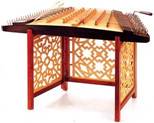RUAN (LUTE)
The ruan is a Chinese plucked string instrument. It is a lute with a fretted neck, a circular body, and four strings. Its four strings were formerly made of silk but since the 20th century, they have been made of steel. The ruan comes in a family of 5 sizes: Gaoyinruan (high pitched) plays soprano, Xiaoruan (small) plays alto, Zhongruan (medium) plays tenor, Daruan (large) plays bass, and Diyinruan (low pitched) plays contrabass.





